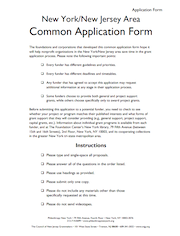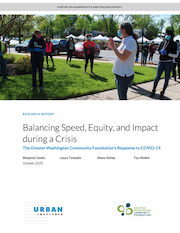Site Search
- resource provided by the Forum Network Knowledgebase.
Search Tip: Search with " " to find exact matches.
This publication from Grantmakers for Effective Organizations offers a framework for thinking about how to measure progress and results in place-based and community change initiatives.
Novartis benchmarked Employee Crisis Programs, and asked fellow corporate funders via the corporate funders listserve to answer the questions below.
- If you have an Employee Crisis Program, what is the name
- Do you manage the program internally or thru a 3rd party? If you use a 3rd party, can you share their name/website and any good/bad experiences.
- Do you only support disasters or other hardships as well?
- What is the average percentage of your employees that apply for aid?
- What is your minimum and maximum funding?
- What is the average amount of aid?
- Do you provide aid directly to the employee and/or vendors?
- Do you allow employees to donate to your fund? If so, how do you promote awareness and what is the employee donation participation rate? Do you match these donations?
- Where does the program reside (CSR, Foundation, HR)?
- Please share guidelines and applications, if possible.
- Please share any other insights.
Sample bylaws for Community Foundations.

A corporate member asked for what other corporations do regarding employee’s goal and objectives. Do they include volunteerism or volunteer activities as part of an employee’s review, or their annual goals?
Sample board committee descriptions, including roles and responsibilities of committee members
The rising cost of housing, a limitation on supply of affordable housing stock, and economic shocks and disruptions have led to an increase in homelessness across the United States. Over this time period, the City of Newark has made strides in fostering collaborative and innovative approaches to housing the unhoused. In December, the City released a strategic plan to end chronic homelessness, the first plan of its kind in some time. Specifically, its vision states that “Newark will strive to end chronic homelessness for all individuals over the next three years through collaboration, prevention, and housing.” The vision goes on to state that when it [homelessness] cannot be prevented, it will be a rare, brief, and nonrecurring experience.”
We hope that you will join us as we hear from leaders of this collaborative effort as they discuss how they are working toward their shared vision.
Panelists:
Luis Ulerio, Newark Homelessness Czar, Director of the Mayor’s Office of Homeless Services
Jim Pelliccio, Chair of the City of Newark Commission on the Homeless and President and CEO of Port Newark
Evan Weiss, President and CEO, Newark Alliance
Cost: Free for CNJG Members; $50 for Non Member Grantmakers.

The COVID-19 public health and economic crisis has changed our world as we know it. As employers moved to remote work, schools shifted to distance learning, and businesses closed completely, it became clear that the impact on residents, nonprofits, and businesses was far greater than anyone could have ever imagined.
In response to the growing and evolving needs of our region, the Greater Washington Community Foundation established the COVID-19 Emergency Response Fund to raise and rapidly deploy funding to local nonprofits providing food, shelter, educational supports, and other critical services.
From the beginning our goal was clear: to address the immediate needs and reach adversely affected communities, particularly low-income households and communities of color. We know all too well that in a crisis like this, these marginalized communities are hit the hardest, and often take the longest to recover.
In times of crises, The Community Foundation is our region’s philanthropic first responder, bringing together individuals and families, philanthropic peers, corporate partners, and local government advisors to address community issues. Building on our rich history of emergency response work, we grounded our COVID-19 response efforts in a similar coordinated approach.
This report chronicles the steps taken, under immense pressure, to develop a coordinated emergency response effort to support a broad range of needs across the region. Once again this effort has demonstrated that working in partnership and close collaboration with our philanthropic peers and local government advisors is an effective way to manage a response to both urgent and longer-term needs.
A CNJG member queried the Health & Aging listserves asking for sample letters of inquiry. This document includes a few responses from fellow members. If you would like to add yours to this list, please email us.
